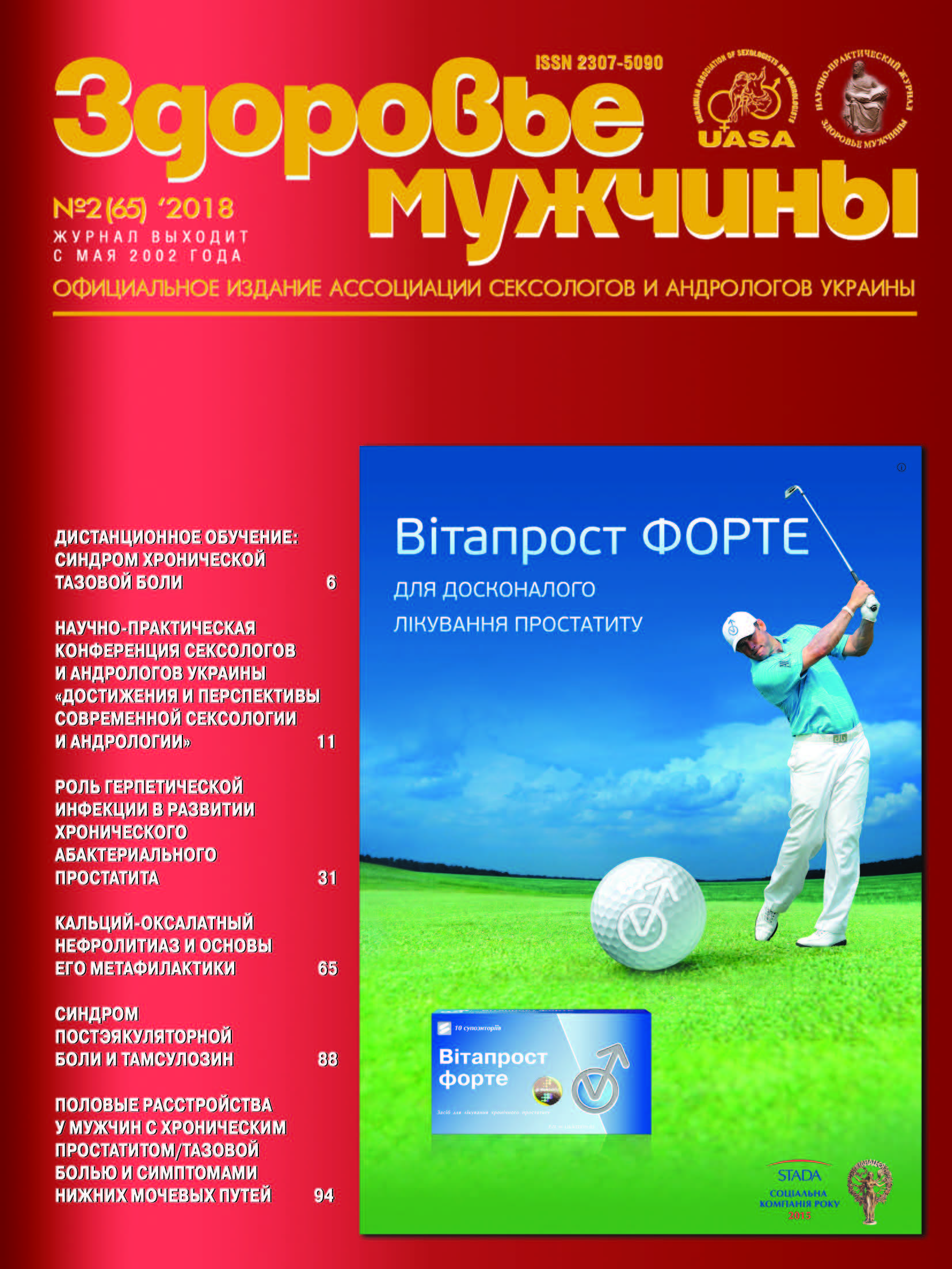Calcium oxalic nephrolithiasis and foundation of its metaphylaxis
##plugins.themes.bootstrap3.article.main##
Abstract
Hypercalciuria is the main lithogenic pathometabolism in calcium nephrolithiasis which manifests with multilateral impairments of metabolic risk factors of recurrent development of kidney stone disease and different types of hypercalciuria. Causes of hypercalciuria can include impairments of gastro-intestinal function, hormonal impairments and their imbalance in the regulation of bone tissue metabolism, impairments of vitamin D metabolism, congenital genetic pathologies and dietary factors.
The objective: was to improve the results of anti-relapse treatment of patients with calcium oxalate nephrolithiasis by studying the pathogenetic aspects of hypercalciuria, developing differential diagnostics of hypercalciuria types, determining the main directions of scientifically based metaphylaxis.
Materials and methods. The study included 100 patients with calcium oxalate nephrolithiasis (67 men and 33 women). The average age of the patients was 38.5 years. 67 (67%) patients had percutaneous nephrolithotripsy, remote lithotripsy in 13 (13%) patients, contact ureterolithotrypsy in 12 (12%) patients, open surgical interventions in 8 (8%) patients, patients.
Results. For performing metaphylaxis of calcium oxalic nephrolithiasis, it is necessary to differentiate types of calcium oxalic nephrolithiasis and choice of adequate treatment. Our study pays attention to absorbent calcium oxalic nephrolithiasis of types I, II, III and IV, renal, resorptive HK and tubular acidosis. There are also presented schemes of metaphylaxis and results of 3-year metaphylaxis of calcium oxalic nephrolithiasis.
Conclusion. Metabolic disorders in patients with urolithiasis are polymorphic in character and require a differentiated approach to establish the type of hypercalciuria, which allows scientifically substantiate metaphylactics, correct lithogenous disorders and reduce the risk of recurrent stone formation during a significant period of treatment.##plugins.themes.bootstrap3.article.details##

This work is licensed under a Creative Commons Attribution 4.0 International License.
Authors retain the copyright and grant the journal the first publication of original scientific articles under the Creative Commons Attribution 4.0 International License, which allows others to distribute work with acknowledgment of authorship and first publication in this journal.
References
Черненко В.В., Черненко Д.В., Желтовська Н.І., Савчук В.Й. Комплексна метафілактика кальцій-оксалатного нефролітіазу// Здоровье мужчины. – 2015. – № 2. – С. 35–41.
Черненко В.В., Черненко Д.В., Желтовська Н.І., Савчук В.Й. Дієтотерапія в метафілактиці кальційоксалатного нефролітіазу / Матеріали наук.практ.конференції «Урологія, андрологія, нефрологія», Харків. – 20–27 травня 2016 р. – С. 251–256.
Черненко В.В., Черненко Д.В., Желтовська Н.І., Савчук В.Й. Комплексне застосування тіазидних діуретиків в метафілактиці Са-оксалатного нефролітіазу / Здоровье мужчины. – 2016. – № 1. – С. 72–74.
Черненко В.В., Черненко Д.В., Нікуліна Г.Г., Мигаль Л.Я., Желтовська Н.І., Савчук В.Й. Морфологічні дослідження кристалів сечової кислоти та її дигідрату у хворих на транзиторну сечокислу гіперкристалурію. Тези доповідей наук. практ.конференції до 100 річчя ДЗ «Дніпропетровська мед.академія» сучасні методи діагностики та лікування в урології, андрології, онкології. – Дніпро, 2016. – С. 61–62.
Голованов С.А., Сивков А.В., Дзеранов Н.К., Яненко Е.К., Дрожжин В.А. Распространенность метаболических типов мочекаменной болезни в московском регионе «Сравнительный анализ 2005–2009 г.» / Экспериментальная и клиническая урология. – 2011. – № 1. – С. 34–35.
Авдошин В.П., Андриохин М.И., Исрафилов М.Н. Комплексное лечение и метафилактика уратного и смешанного нефролитиаза. – М., 2012. – С. 32.
Hongshi Xu, Zisman Al, Col Fl, Worcester E.M. Kidney stounes an update on current pharmacological management and future directions // Expert opin pharmacother. – 2013. – V. 14, № 4. – Р. 435–447. https://doi.org/10.1517/14656566.2013.775250
Rim M.J., Mayr M. Rezidivierende nephrolithiasis – wie weiter? // Praxis. – 2013. – Vol. 102, № 19. – Р. 1177–1188. https://doi.org/10.1024/1661-8157/a001426
Лукьянников А.С., Королевская Л.И. Гипопаратиреоз и гипокальциемический синдром // Клиническая медицина. – 2003. – № 1. – С. 66–70.
Graven B.L., Passman C., Assimos D.E. Hypercalcemic states associated with nephrolithiasis // Rev.Urol. – 2008. – Vol. 10, № 3. – P. 218–226.
Pohlman T., Hruska K.A, Menon M. Renal tubular acidosis // Urol. – 1984. – Vol. 132, № 3. – Р. 431–476.
Kok D.J. Khan Sr Calcium oxalate nephrolithiasis. A free or fixed particle disease // Kydney int. – 1994. – Vol. 46, № 3. – Р. 847–854. https://doi.org/10.1038/ki.1994.341
Dasgupta D., Wee M.J., Reyes M., Li Y., Simm P.J., Sharma A, Schlingmann K.P., Janner M., Biggin A, Lazier J. Mutations in SLC34A3/NPT2c are associated with kidney stones and nephrocalcinosis // J.Am. Sac Nephrol. – 2014. – Vol. 25, № 10. – Р. 2366–75. https://doi.org/10.1681/ASN.2013101085





